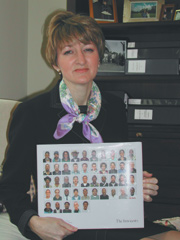Living With Convictions
By Cindy Edwards
Freedom
is one of the greatest
civil liberties that we possess as citizens of the United States.
Our emancipation from slavery and oppression, our political independence,
public commerce and unrestricted access to the globe is mostly
unsurpassed by other nations. As we “pledge allegiance to
the flag,” we also profess faith in our judicial system
and ensure “justice for all.” But suppose there was
a breakdown in the system and one day, by no fault of your own,
you were wrongly convicted of a crime, stripped of your freedom
and locked away for life or even sentenced to death. What would
you do then?
 Believe
it or not, an estimated 10 percent of our national prison population
may be innocent of their convictions. That’s approximately
200,000 people who may be wrongfully convicted currently serving
time in American prisons. Believe
it or not, an estimated 10 percent of our national prison population
may be innocent of their convictions. That’s approximately
200,000 people who may be wrongfully convicted currently serving
time in American prisons.
Thankfully, there are people like Julia Sullivan. As an Annapolis
attorney and board member for the Innocence Project of the National
Capital Region (IPNCR), Sullivan has convictions of her own—moral
convictions—and she is committed to the exoneration of inmates
who are incarcerated for crimes they did not commit.
“The Project is a lifeline to those individuals who have
been wrongly convicted and sometimes that’s all they have
to hang on to,” says Sullivan. “We receive about 50
letters per month requesting assistance, and we take each one
seriously.” It is estimated that there are at least 23 exonerees
in the tri-state region alone.
Julia Sullivan displays photos of 45 men and women wrongly convicted
and later exonerated.
IPNCR was established four years ago as a non-profit corporation
to provide pro bono investigative and legal assistance to innocent
inmates who are incarcerated in Maryland, Virginia and Washington,
D.C. IPNCR is comprised of an active 15-member board of directors,
an honorary board of prominent community members and exonerees,
a constantly growing network of attorneys, law students, and a
full-time project coordinator. The Project is a catalyst for the
validity of criminal cases to be re-evaluated and the exoneration
of wrongly-convicted individuals granted.
 The protocol for potential clients is both lengthy and time-sensitive
for innocent inmates who remain mostly in solitary confinement
and are serving life sentences or facing execution. “Each
letter we receive is carefully reviewed to determine its legitimacy
and eligibility,” Sullivan explains. “And there are
some very strict deadlines that must be met.” Such deadlines
include Virginia’s notorious 21-day rule whereby a convicted
party is given a mere three weeks to file an appeal despite the
fact that it is literally a matter of life and death.
The protocol for potential clients is both lengthy and time-sensitive
for innocent inmates who remain mostly in solitary confinement
and are serving life sentences or facing execution. “Each
letter we receive is carefully reviewed to determine its legitimacy
and eligibility,” Sullivan explains. “And there are
some very strict deadlines that must be met.” Such deadlines
include Virginia’s notorious 21-day rule whereby a convicted
party is given a mere three weeks to file an appeal despite the
fact that it is literally a matter of life and death.
“I currently have two innocence cases because we received
the letters so close to deadline that it was not possible to go
through the entire process which could take up to a year.”
Sullivan’s compassion is intelligible, and beneath her gentle
disposition is a propitious determination.
If requirements are satisfied and there is time for the entire
process, the investigative method begins. “We have office
space at American University where students work cases on a semester
basis and earn college credit,” Sullivan says. “It’s
such a rewarding opportunity for students to have hands-on experience
with the legal system and real-life clients. We receive such positive
feedback from everyone involved, and many students are enthusiastic
about working with us once they receive their law degrees.”
Georgetown University Law Center, Catholic University’s
Columbus School of Law, and the University of the District of
Columbia Law School are also involved. The Project hopes to become
active in a Maryland school soon.
So just how is it that innocent people are sent to prison? According
to Sullivan, “There are several factors that could contribute
to an innocent person being convicted. For example, mistaken identity
commonly plays a role in wrongful convictions, and DNA testing
can often prove innocence in those situations.” But the
Project maintains that DNA testing alone cannot remedy what ails
the criminal justice system and that policymakers must not only
accept responsibility but also promptly address the intricacies
of the dilemma. Other factors in wrongful convictions include
false confessions, ineffective assistance of counsel, police or
prosecutorial misconduct, tainted informants, and defective or
fraudulent science.
Once a case is fully investigated, it is handed over to a law
firm. “By the time the case goes to a firm, it’s ready
for trial and is seen as a winnable case,” says Sullivan.
“We remain active only as advisors to those firms at that
point.” Throughout the process, the Project serves as a
resource to provide training as needed, case management, and administrative
aid.
Unfortunately, by the time of exoneration, innocent inmates have
already spent an average of nine years in prison and still others
spend a lifetime or are even executed.
Additionally, the Project is committed to raising public awareness
about the vulnerabilities within our judicial system as well as
the critical need for reform. One of the outlets for this is a
play called “The Exonerated.” “The production
is a one-act narrative that dramatizes the real-life stories of
five wrongfully convicted inmates,” explains Sullivan. “The
set is very austere with just five park benches, and every word
in the play was actually spoken by exonerees. They share what
their alleged crime was, how they were convicted, exonerated,
and their lives after exoneration.” There have been several
performances throughout the country already, and the cast has
included Harry Belafonte, Richard Dreyfuss, Mia Farrow and Susan
Sarandon.
Sullivan places great emphasis on the issue of life after exoneration.
“Assimilation into society after wrongful incarceration
is a major issue,” she says. “We have found that when
[people are] in prison, they hold on to life as they knew it before,
but it keeps moving ahead without them. In other words, they want
their life back and sometimes it’s just not there. They
have literally been robbed of that life through no fault of their
own.” She continues, “It’s really complex and
we, the lawyers, are good at the legal end, but we are not experts
on the assimilation process.”
With respect to that concern, the Project has joined forces with
Marymount University and, together, they are focused on assembling
a network of professionals who can be accessible for those who
were wrongfully convicted. “Interestingly, we have found
that exonorees have the most in common with ex-POWS, and we’re
taking that into account,” says Sullivan. “In many
ways their experiences are very much alike.”
What is the solution to rectify the tragedy of wrongful convictions?
“Legislation and reform are vital elements,” says
Sullivan. “The Innocence Protection Act (IPA) of 2003 is
an active response and addresses several key components.”
The IPA proposes significant changes that include expanding the
access and funding for DNA testing in appropriate cases, establishing
standards of competency for defense representation at trial as
well as funding for capital defense. The need for standardization
in the preservation of biological evidence in criminal cases is
petitioned, as is the necessity to increase the dollar amount
of compensation that may be awarded in federal cases of wrongful
convictions.
The IPA has gained tremendous momentum in Congress and is co-sponsored
by Sen. Paul Sarbanes (D-MD). Other local supporters include Don
Murphy, former delegate, and Gil Genn, lobbyist for Genn &
Murphy, LLC, as well as board member Clarence Goldberg.
Coincidentally, the first person in the U.S. to be exonerated
of a capital conviction through DNA testing is a Maryland resident.
Kirk Bloodsworth remains active in criminal justice reform after
being a victim of mistaken identity when he was arrested for the
brutal rape and murder of a 9-year-old girl in 1984. He was sentenced
to death despite his unfaltering proclamation of innocence and
served nearly nine years in prison before being exonerated. Meanwhile,
the real perpetrator continued to walk the streets. (He was arrested
on other charges one month after the crime and has been incarcerated
ever since.)
As an advocate of the Innocence Protection Act of 2003, Bloodsworth
gave this statement: “This legislation is so important because
it will help prevent sending innocent people to death row, help
make sure those who are truly guilty are caught, and help prevent
more innocent victims from being created. It took nearly 20 years
of struggle by my family and me to finally clear my name. Congress
should act immediately to pass this critical legislation to prevent
any more stories like mine.”
Perhaps the aforementioned question, “What would you do”
merits a valiant and compelling addendum for summation of this
topic. What will you do to uphold your oath so that we remain
“indivisible with liberty” and provide “justice
for all”?
For more information, call 202-274-4199 or visit www.wcl.
american.edu/innocenceproject .
Cindy Edwards enjoys the adventure of life and writing about it. She is an
avid reader, traveler and yoga practitioner who resides in Annapolis with her
husband and her dog.
|
Back
|

